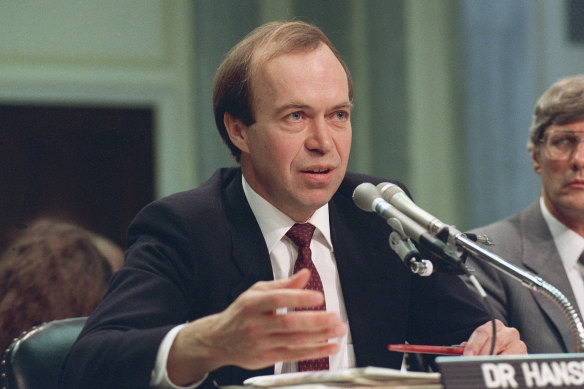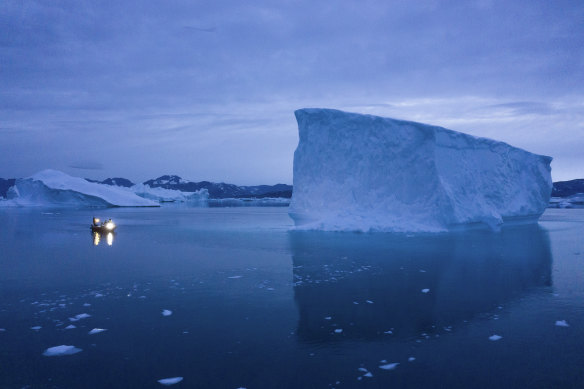“There has been a tendency to exaggerate the science in favour of ‘doomist’ narratives,” he told this masthead this week. “That helps nobody – except the fossil fuel industry of course.”
For billions of people on earth, the stakes of the debate could not be higher, and at its heart is what Hansen calls our Faustian bargain with the fossil fuels.
Pollution that both heats and cools

James Hansen, director of NASA’s Goddard Institute for Space Studies in New York, warned the US Congress in 1988 that human-induced global warming was already underway.
(This photo taken in 1989.)Credit: AP
What he means is that many of the industrial processes that release warming gasses like methane and carbon dioxide into the atmosphere also release sulfur dioxide and nitrogen dioxide. These gasses, while dangerous, also have a short-term cooling effect because they reflect some heat back into space.
As a result, says Hansen, some of our pollution is masking the heat we have already locked into the system, and as we strip out the pollution the mask is being lifted and warming is accelerating.
Hansen, and some others, believes that climate models used by scientists around the world, and the United Nations Intergovernmental Panel on Climate Change, have failed to adequately take the impact of aerosol masking into consideration.
This might explain the extreme temperatures of the past 12 months, and suggests that climate change will hit harder and faster than governments are being told.
So how hot has been?
Last month, the European Union’s Earth Observation Program, known as Copernicus, announced that, according to its data the world had just gone through its first 12-month period with the world’s average temperature at 1.5 degrees above the pre-industrial average – which is in line with Hansen’s grim warning in November.
Dr Zeke Hausfather, a climatologist with the University of California, Berkeley, says it is hard to capture the extraordinary heat of the previous year by looking at averages. Instead, he looks at the awful peaks, noting extremes recorded in the Arctic and Antarctic, parts of Asia and the Americas. For periods of the northern summer, the waters off parts of Florida reached an unimaginable 38 C, beating a previous world record water surface temperature in Kuwait Bay in 2020. “That is a hot-tub temperature,” he says.

Extreme temperatures have been recorded in the arctic.Credit: AP
Also lending weight to Hansen’s analysis has been the extreme temperatures recorded as recently as this week. Maximiliano Herrera, a climatologist and weather historian who monitors extreme weather events, has a social media feed that is now a litany of shattered records. “South Africa is living a madness. Months with thousands of records destroyed every day,” he wrote on Wednesday. “Today 45.1C at Vioolsdrif, latest 45C in Southern Africa history.”
Days before he noted a temperature recorded in Turkmenistan of 35C, 10 degrees above the previous record. “Latin America is boiling from Mexico to Argentina,” he wrote a day earlier. “Guyana 37.4 at Lethem, hottest March day in Guyana history set twice in few days.”
The models
Asked if he believes Hansen is right, Hare pauses carefully. “You know, I think it’s a dangerous thing to challenge Jim Hansen. Right. So one needs to be very, look very carefully at what he’s arguing.”
But Hare says people who have looked carefully at what Hansen is arguing, like those at that grim dinner party, have come to the conclusion that the UN’s synthesis of climate models does adequately take in the aerosol effect.

Michael Mann counsels against ‘doomism’ despite the alarming data coming in.
He explains that the UN’s synthesis of climate models takes into account the full range of available climate modelling, with hundreds of scenarios from individual models.
These models have been carefully tested by backcasting – that is, running observed climate data from previous decades through them to see that they are accurate. Those that are found to be “too hot” compared to actual weather observations are given reduced weight in future projections.
Hausfather is cautious about dismissing Hansen’s position too. “All of 2023 was exceptionally warm, but it was really weird in the last four months, and that is why a lot of climate scientists are a little freaked out,” he says.
Hausfather explains that since we started pumping warming gasses into the atmosphere during the industrial revolution the world has warmed by about 1.3 degrees. A strong El Nino can force up the average temperature by around 0.2 degrees in addition to this at and after its peak.
These two drivers would explain why the average global temperature is being recorded at around 1.5 degrees now, as the current El Nino ebbs, but it does not explain the extreme temperatures recorded between August and November.
He makes another point too. Over recent decades the world has been warming by around 0.2 degrees a decade, so when we have an El Nino we catch a glimpse of our future, of the temperatures we can expect to live through in a decade.
That’s what has made the past year so horrific to some climate observers.
Like Mann and Hare though, he does not believe the lack of clear explanation for the savage heat of the past year necessarily means that Hansen is right in arguing that models are broken and the 1.5 degree target lost.
Loading
Under the terms Paris Accord, the 1.5 degree target is not considered broken unless average temperatures remain above it for years. The agreement takes into account the possibility that even if the world manages to reduce emissions adequately it might experience temperatures above that mark for years before they stabilise and begin to fall later in the century.
All agree that, though this recent heat is alarming, and that it has challenged the boundaries of the UN’s most recent modelling, the model still stands. And they agree that temperature increase is accelerating.
And all agree that even if Hansen’s most dire predictions do not prove to be correct, there is little joy in the current data.
“As I like to say, the truth is bad enough,” says Mann. “There’s no reason to exaggerate to make the case for urgent action.”
Get to the heart of what’s happening with climate change and the environment. Sign up for our fortnightly Environment newsletter.
